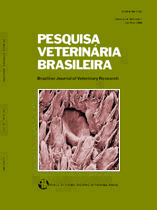 |
|
|
|
Year 2011 - Volume 31, Number 1001
|

|
Factors affecting immunoglobulin concentration in colostrum of healthy Holstein cows immediately after delivery, 31(Supl.1):53-56
|
ABSTRACT.- Gomes V., Madureira K.M., Soriano S., Della Libera A.M.M.P., Blagitz M.G. & Benesi F.J. 2011. Factors affecting immunoglobulin concentration in colostrum of healthy Holstein cows immediately after delivery. Pesquisa Veterinária Brasileira 31(Supl.1):53-56. Departamento de Clínica Médica, Faculdade de Medicina Veterinária e Zootecnia, Universidade de São Paulo, Av. Prof. Dr. Orlando Marques de Paiva 87, Cidade Universitária, São Paulo, SP 05508-270, Brazil. E-mail: viviani.gomes@usp.br
This study analyzed the influence of the number of milkings, number of births, and udder quarter in immunoglobulin (Ig) concentration in the colostrum of healthy Holstein cows. It was collected two samples of colostrum by manual milking, getting the first jets to completion of bacteriological examination and immunoglobulin levels by radial immunodiffusion test in agar gel. Positive samples for bacteriological examination were excluded from this investigation. Medians of immunoglobulin’s G, A and M in the colostrum collected before the first and second milking were respectively 9,200 and 6,400mg/dL (p=0.0029); 400 and 200mg/dL (p=0.0018); 800 and 400mg/dL (p=0.0001). Median immunoglobulin concentration in animals that calved once, twice or three times or in cows that calved 4 to 6 times were 6,400; 6,400; 3,200 and 11,200mg/dL IgG; 100, 200, 100 and 800mg/dL IgA ; and 400, 400, 100 and 800mg/dL IgM, respectively. Concentrations of IgG, IgA and IgM were greater in animals that calved more than 4 times (p<0.05). Medians of IgG, IgA and IgM in the right fore quarter (RF), right hind quarter (RH), left fore quarter (LF) and left hind quarter (LH) were, respectively, 7,800; 6,400; 7,800 and 6,400mg/dL; 200, 200, 200 and 200mg/dL; and 400, 400, 400 and 400mg/dL. Ig concentrations in the colostrum of Holstein cows were influenced by the number of milkings after delivery and number of lactations. These variations may be considered risk factors to passive immunity transfer to newborn calves, predisposing them to diseases and causing economic losses to dairy production. |
| |
|
|
| |
|
 |